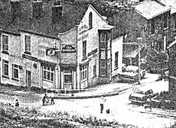“Sheffield seems to me, by daylight, one of the most appalling places I have ever seen. In whichever direction you look you see the same landscape of monstrous chimneys pouring forth smoke which is sometimes black and sometimes of a rosy tint said to be due to sulphur. You can smell the sulphur in the air all the while.” George Orwell wrote this in his diary in 1936, when preparing to write The Road to Wigan Pier. At the time he was lodging at 152 Wallace Road, the home of Gilbert and Kate Searle, at Parkwood Springs.
“Even the shallow river that runs through the town is usually bright yellow with some chemical or other,” Orwell continued, presumably referring to the River Don which bounds the Parkwood area to the west. At night, from the hillside above he looked across the Don valley and saw “lamps twinkling like stars. Huge jets of flame shoot periodically out of the roofs of the foundries (many working night shifts at present) and show a splendid rosy colour through the smoke and steam.” It was then that Sheffield assumed “a kind of sinister magnificence.”
Orwell disliked the place, but liked the people. “I was quite sorry to leave the Searles,” he wrote. “I have seldom met people with more natural decency.” Parkwood Springs was like a village, a triangle with the railway on one side and open space on the other two. It had its own churches, stores, pubs and fish and chip shops. People who lived there remember it fondly as a safe place where neighbours were supportive.
The inhabited area is marked in yellow on the map, and the open space in green. Beyond the village, the open space included the original Park Wood, which was cut down for use as fuel during the depression of the 1930s.
Close to steelworks which formed a target for German bombers in World War II, Parkwood suffered during the blitz on Sheffield. One bomb destroyed a bus, killing its passengers. Above the town, near the modern viewpoint, an anti‐aircraft gun was mounted, and barrage balloons were used to deflect air attacks.
Parkwood Springs was inhabited until the mid 1970s, when it was demolished, and its inhabitants have dispersed across Sheffield and even as far as Australia. We were delighted to find that when we published the first Parkwood Springs into Action, many people were interested in the history of the area. They know a lot more about it than we do, and we would be very pleased if they would get in touch with us and pass on their knowledge.
Contact details
To contact the editor, phone 0114 244 6122 or email sia@fitting‐up.org.uk. To contact the Parkwood Group, email parkwood.springs@googlemail.com or visit our web site at http://www.parkwood-springs.org.uk



Logged in users of the website can add comments to this page.
Login to this site if you'd like to add a comment. Sign-up for an account if you are not currently a member.